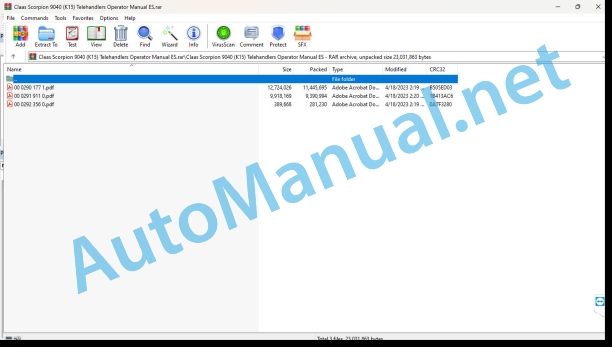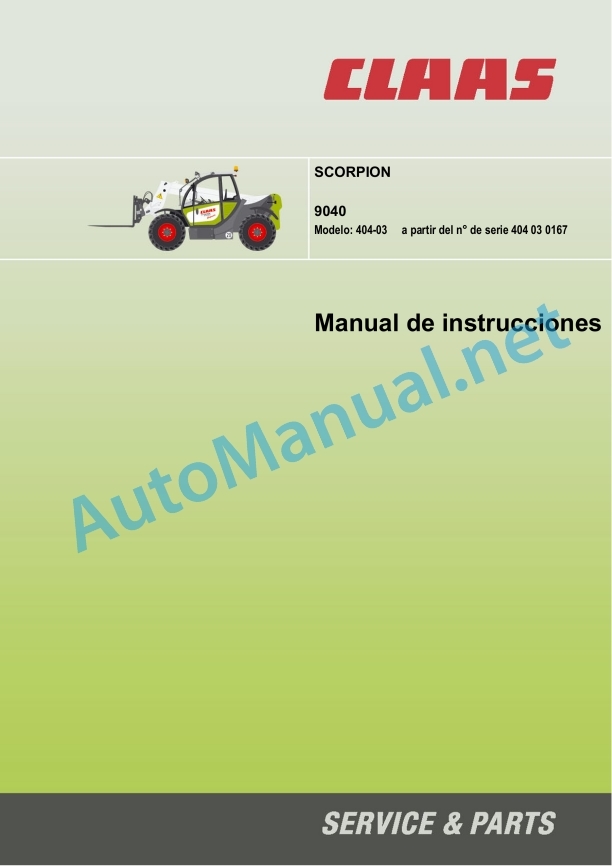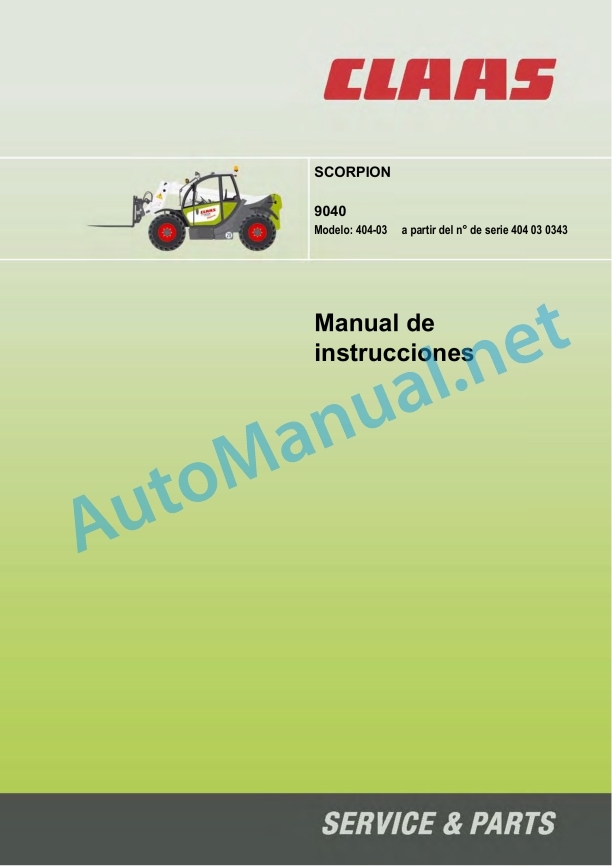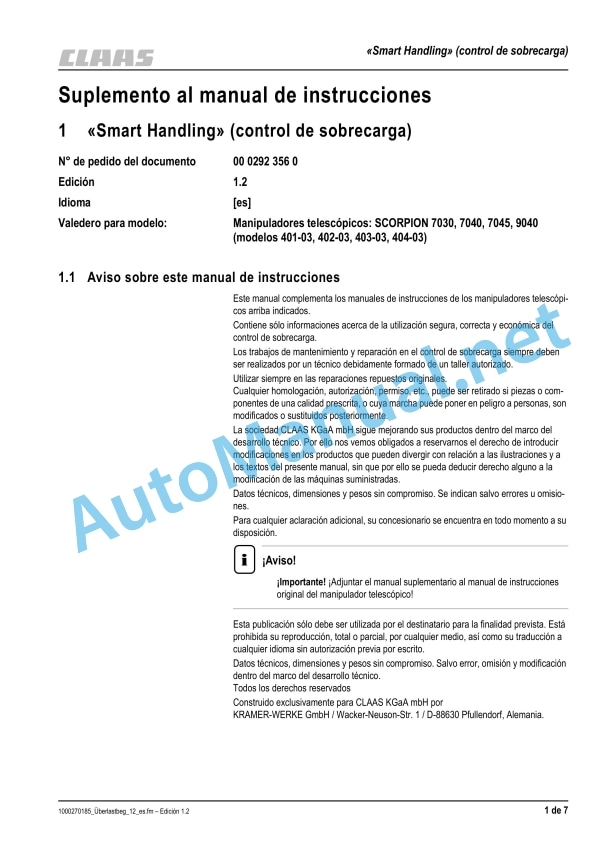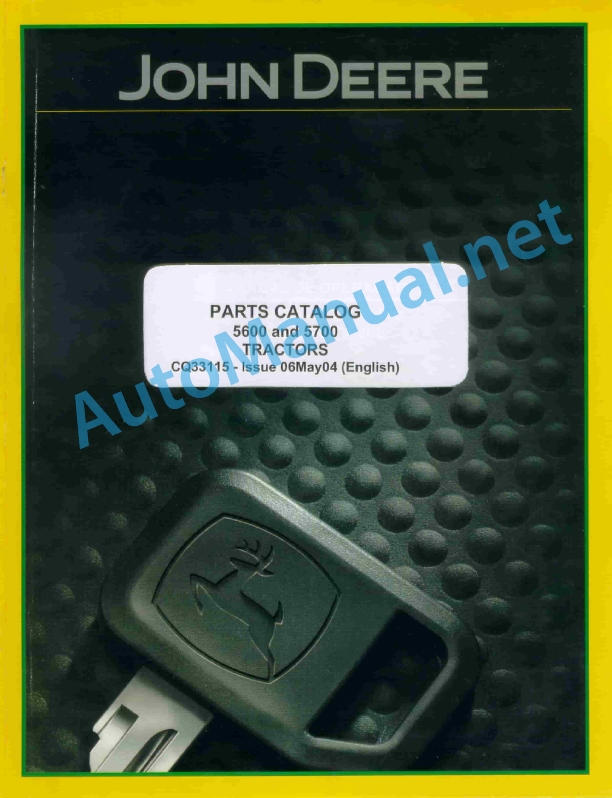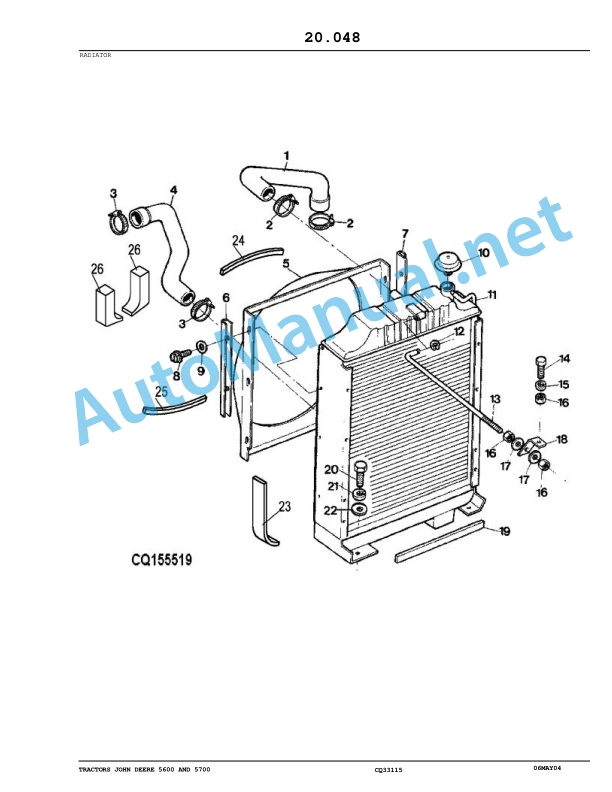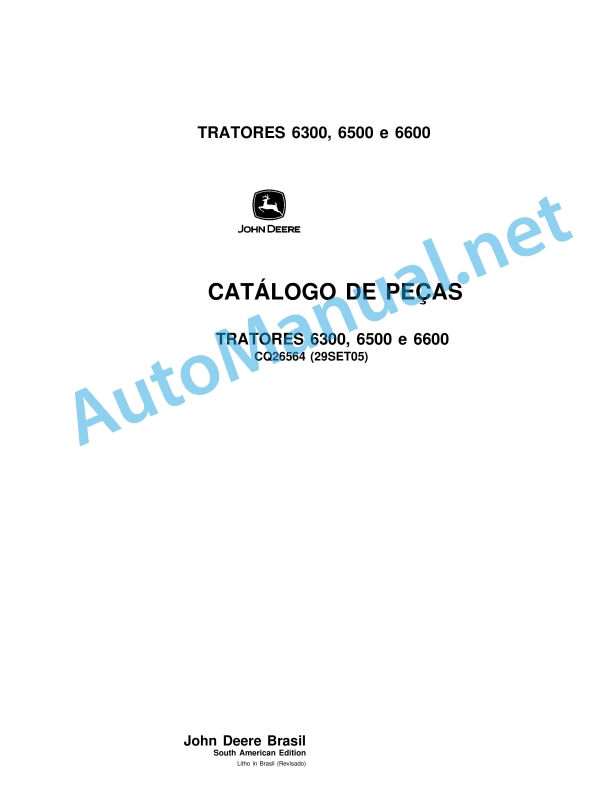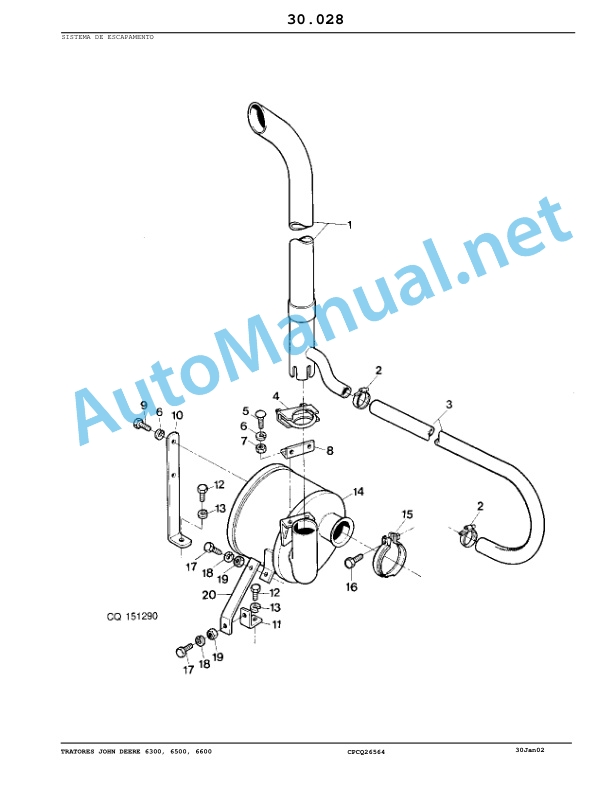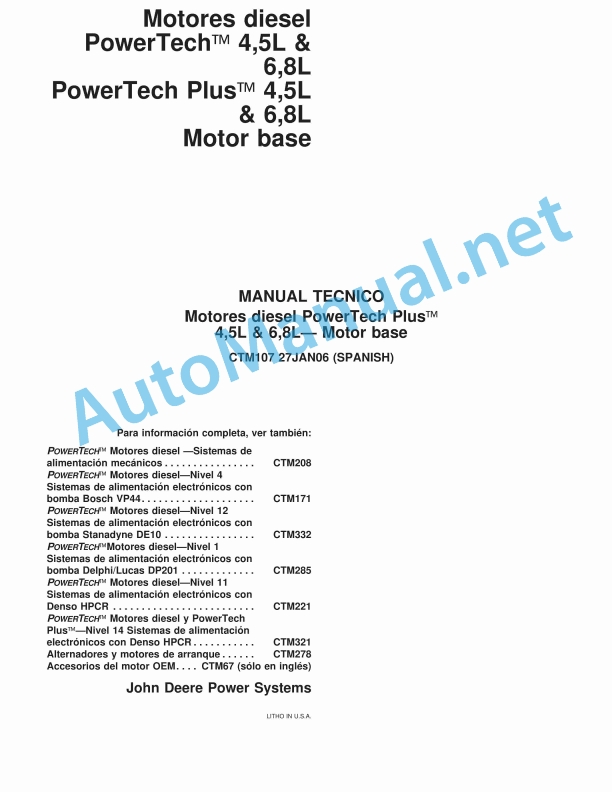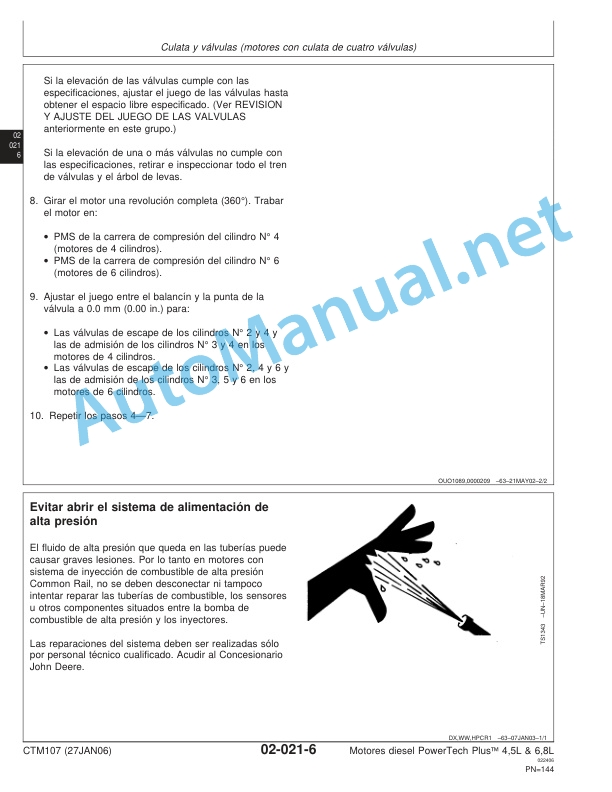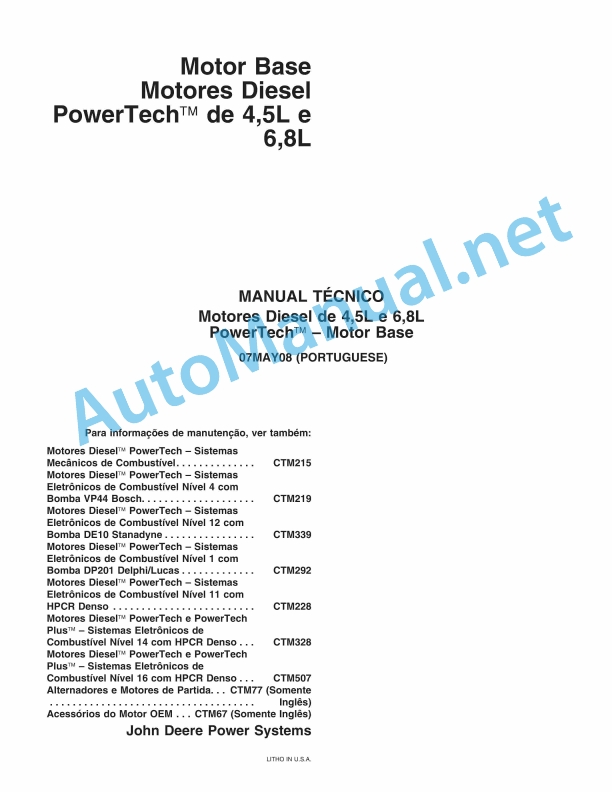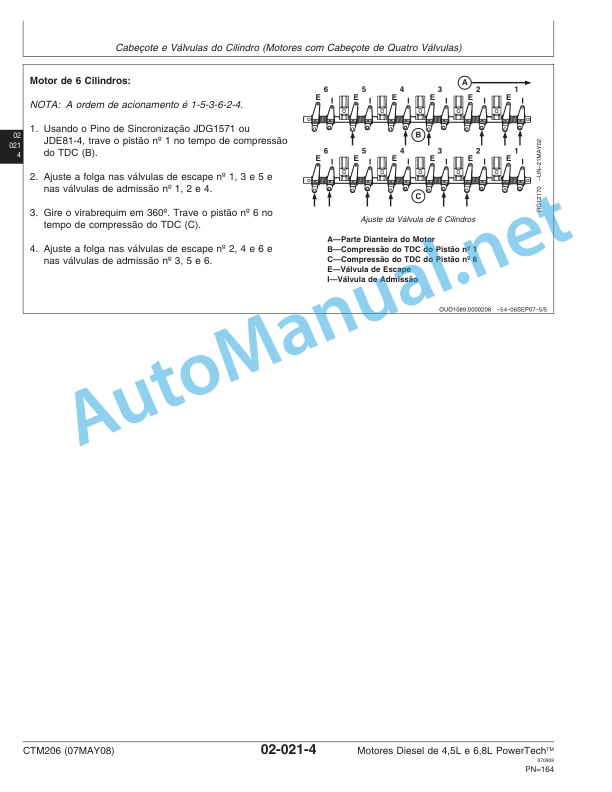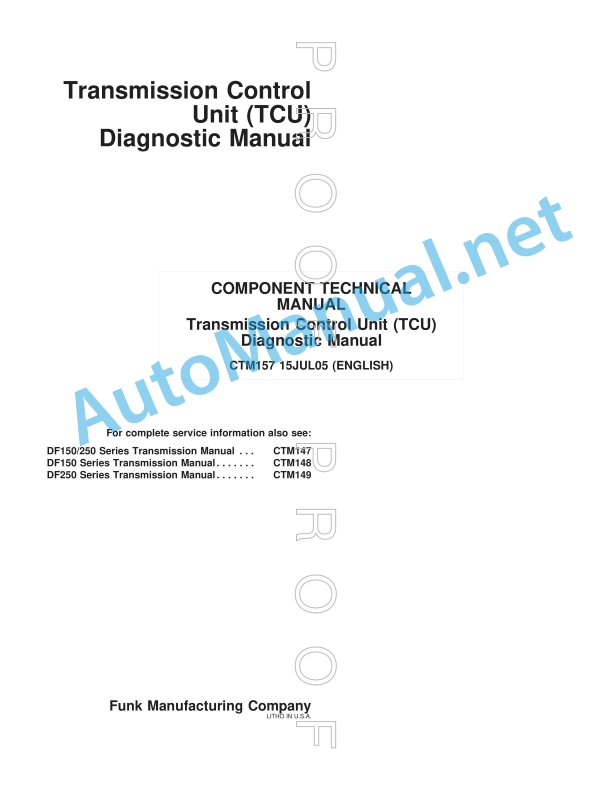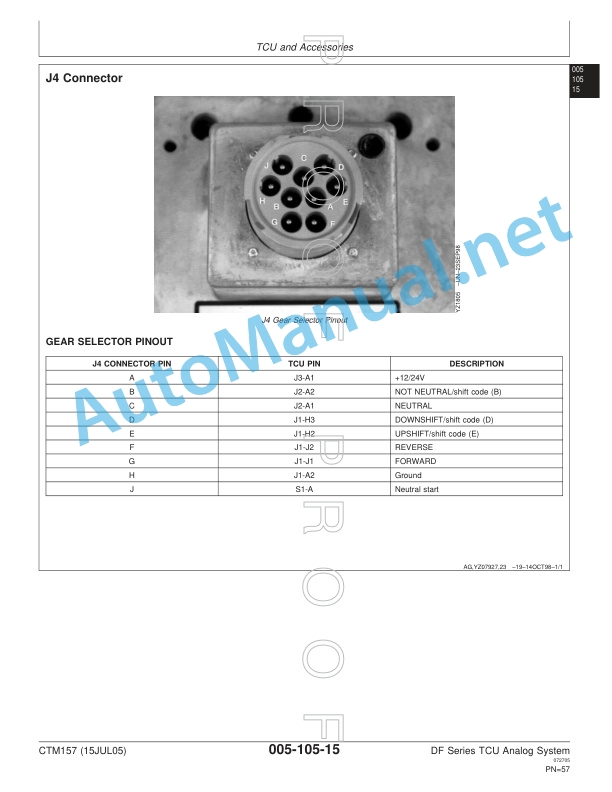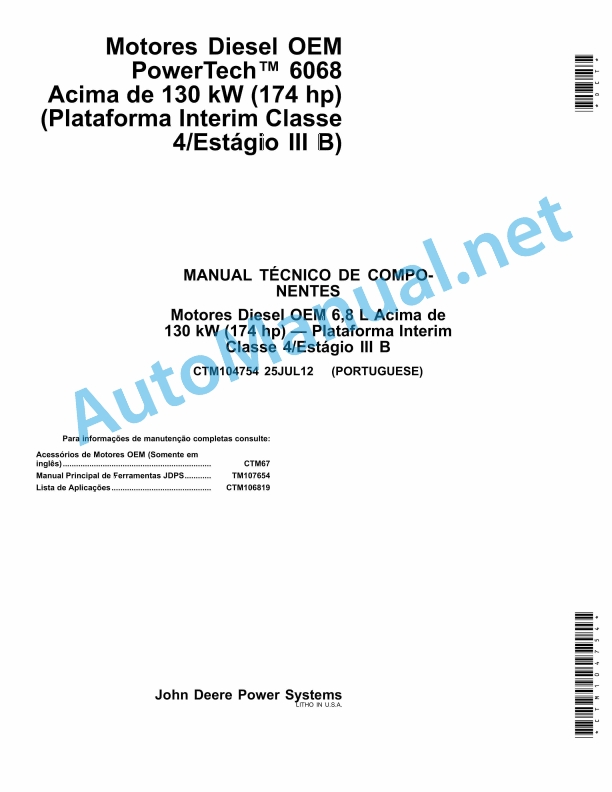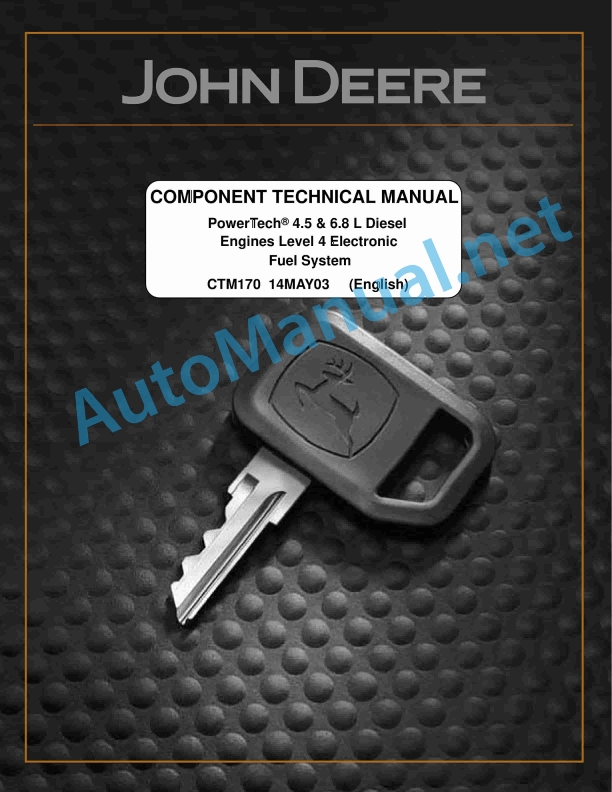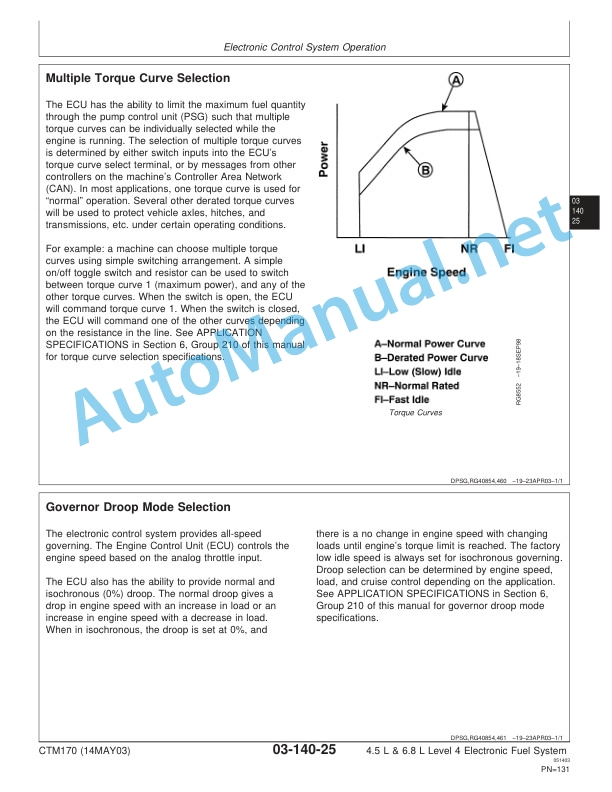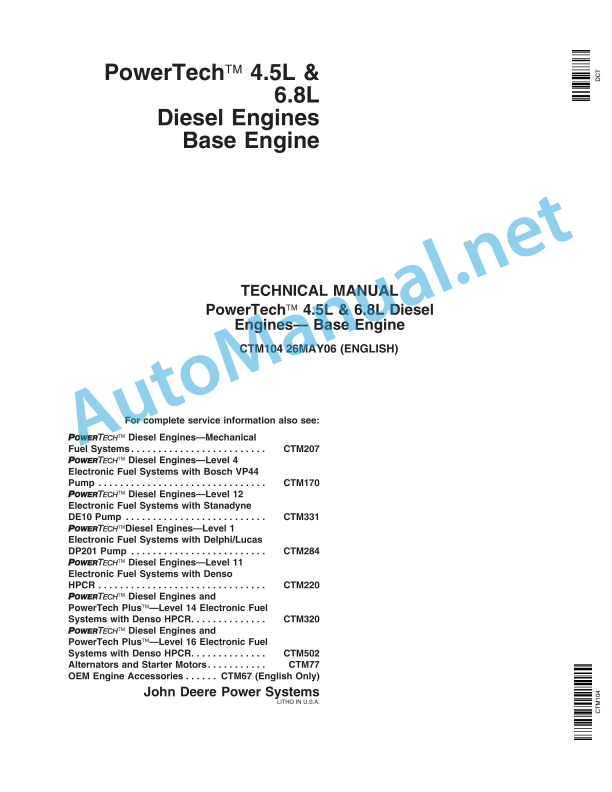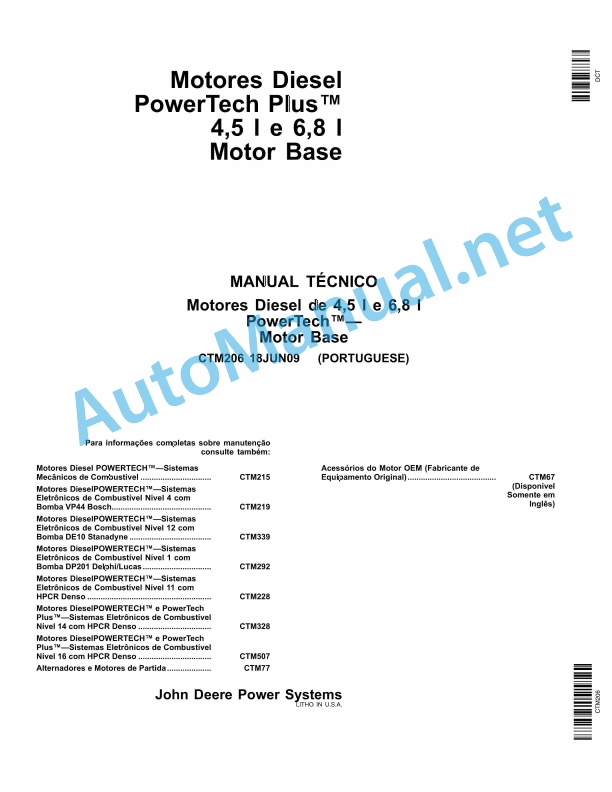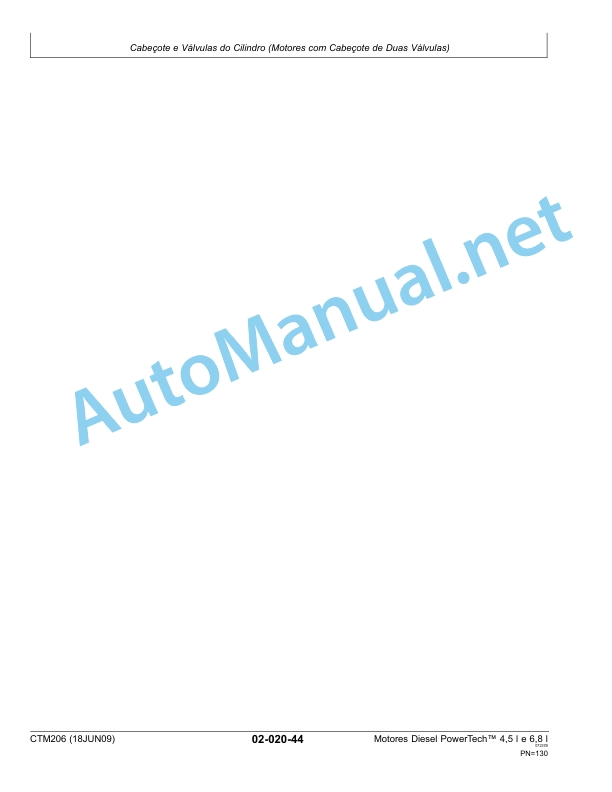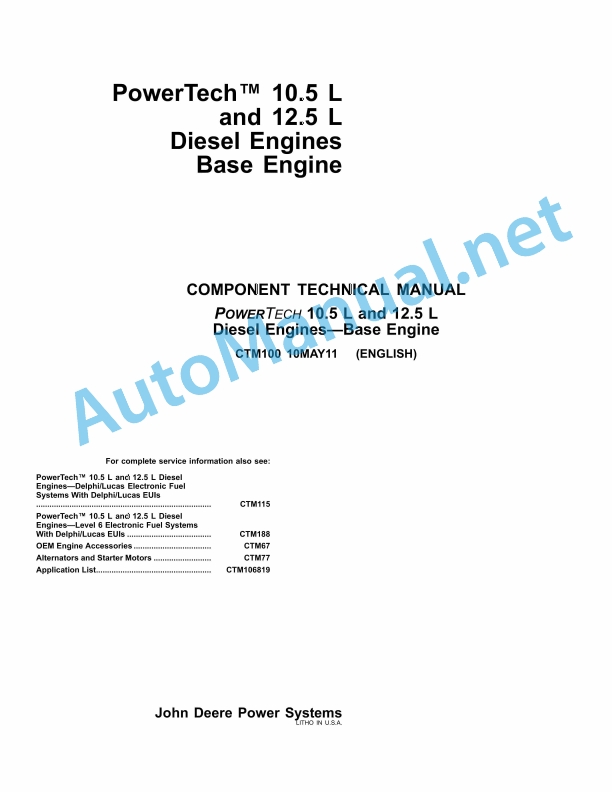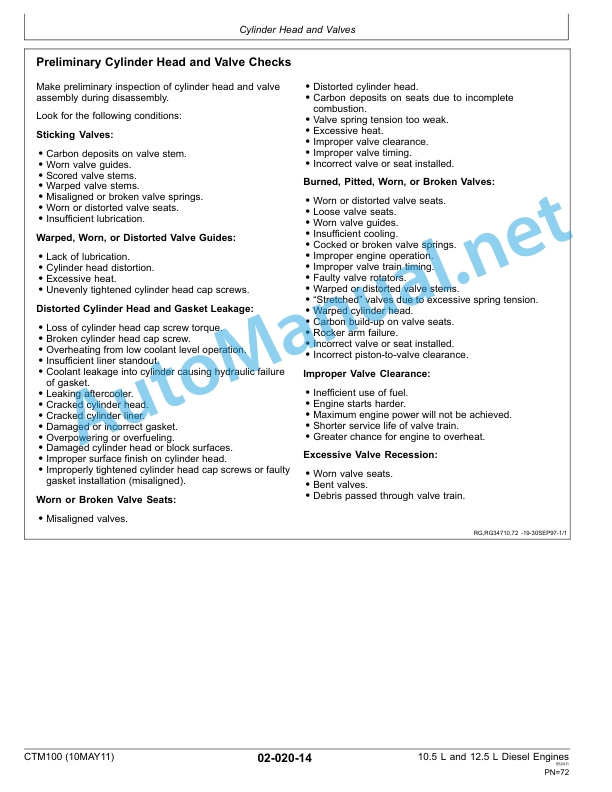Claas Scorpion 9040 (K15) Telehandlers Operator Manual ES
$50.00
- Model: Scorpion 9040 (K15) Telehandlers
- Type Of Manual: Operator Manual
- Language: ES
- Format: PDF(s)
- Size: 20.1 MB
File List:
00 0290 177 1.pdf
00 0291 911 0.pdf
00 0292 356 0.pdf
00 0290 177 1.pdf:
1. Introduction
1.1 General information about the instruction manual
Abbreviations/symbols
General information on the safe use of the machine
1.2 Global view of the machine
1.3 Model name – commercial name
1.4 Synoptic description of the telehandler
General information about the machine
Main components of the machine
Hydrostatic propulsion
Working hydraulics and steering on all 4 wheels
Refrigeration system
1.5 Telehandler Warranty
Information about the warranty
1.6 Areas of application and use of the telehandler with implement
Implements with authorized specific weights
1.7 Provisions
Driving license
Registration/ID
Adjust the headlights of the machine
Machine inspections
Onboard equipment
Documents on board the machine
Telehandler warning signs on public roads (option)
1.8 Nameplates and equipment numbers
Serial number
Cabin number
Engine number
Hydraulic pump number
variable engine number
Variable engine number (quick change option)
Front and rear axle number
1.9 Description: signs
Labels on the outside of the machine
Labels inside the machine
2 Safety instructions
2.1 Identification of warning and danger statements
2.2 Appropriate use and exclusion of liability
2.3 Rules of conduct and general safety instructions
Organizational measures
Selection and qualification of personnel, basic obligations
2.4 Safety instructions for operation
Normal functioning
Lifting equipment
Trailers and implements
Transport
2.5 Safety instructions for maintenance and care
2.6 Maintenance work on ROPS/FOPS protection structures
Cabin, protective arch, protective grille
2.7 Information on special hazards
Electric power
Gas, dust, steam, smoke
Hydraulic system
Oils, greases, and other chemicals
3 Management
3.1 Control elements: overview
3.2 Cabin overview
3.3 Overview: instrument panel, multifunction lever, switch consoles
3.4 Description of witnesses and pilots
Witnesses and pilots – indicating instrument
Witnesses and pilots – instrument panel
3.5 First start-up
Safety instructions on start-up
Important instructions for operating personnel
Break-in time
“Startup” checklist
“Operation” checklist
“Machine Stop” Checklist
3.6 Cabin
Lock and unlock the door
Open, close and half-open the side window
Open the side window completely and lock it
Open/close the rear window
Emergency exit through the rear window
3.7 Hood
Open/close the engine hood
3.8 Starting the diesel engine
Preparations for starting the engine
To start the engine
gat low load
stop the engine
3.9 Main battery switch
Disconnect/connect the main battery switch
3.10 Error code display (103 kW diesel engine)
Flashing code reading
Warning limit – coolant temperature
Warning limit – charge air temperature
Warning limit – engine oil pressure
Error code overview
3.11 Electronic immobilizer with key system (option)
Coding (“instructing”) new ignition keys
Activate (lock) the electronic immobilizer
Deactivate (unlock) the electronic immobilizer
Delete coded keys
Security features
3.12 Electronic immobilizer with code entry (option)
Enter/modify personal code
Activate the electronic immobilizer
Deactivate the electronic immobilizer
Putting the electronic immobilizer out of service
Putting the electronic immobilizer back into service
Disconnect the power supply to the electronic immobilizer
Electronic immobilizer maintenance
3.13 Oil fuel preheatoption)
Oil preheating (option)
Fuel preheating (option)
3.14 Starting the engine with jumper cables (external battery)
Safety instructions for external starting aid
Procedure for external starting aid
3.15 Before starting the journey
Special instructions for driving on public roads
Check the operation of the brakes, steering and lighting
Raise bucket to transport position
Lock the control lever (joystick) and the 3rd control circuit (implements)
3.16 Address
Steering column height and tilt adjustment
Check address
Synchronize address
Switch to front axle steering
Switch to 4-wheel steering
Switch to diagonal direction (crab step option)
3.17 Accelerator
3.18 Manual throttle (option)
3.19 Brake pedal/inching
Specific instructions regarding the brake/inching pedal control
Inching with the brake pedal/inching
Braking with the brake pedal/inching
3.20 Parking brake
General information about the parking brake
Set the parking brake
3.21 Moving forward with the telehandler
Driving speed selection 0 – 20 km/h (30/40 km/h option)
Changing direction of travel (forward/reverse)
Select driving speed (creep device option)
3.22 Stop/park the machine
Longer machine shutdown
3.23 Load stabilizer
General information about the function of the charge stabilizer
Connect or disconnect the charge stabilizer
3.24 Differential lock
Important note about differential lock
Engage/disengage differential lock
3.25 Backup warning (option)
Information about the backup warning
3.26 Electric mirror adjustment (option)
Adjust the rearview mirror
3.27 Machine lighting
General information on machine lighting
Machine lighting control
Work light control
Interior lighting control (cabin)
3.28 Signaling system
Turn signal control
Emergency flasher control
Rotating warning light control (option)
3.29 Cabin heating and ventilation
Heating and ventilation system control
3.30 Air conditioning system (option)
Air conditioning system control
3.31 Windshield washer/rear window washer system
Windshield washer/rear window washer system control
Windshield washer/rear window washer system reservoir
3.32 Seat
Seat adjustment overview
Weight adjustment
Height adjustment (air suspension seat, option)
Backrest adjustment
Longitudinal adjustment
3.33 Seat belt (lap belt)
Specific instructions about the seat belt
Fasten the seat belt
Release the seat belt
Lengthen/shorten lap belt
3.34 Fire extinguisher (option)
Fire extinguisher control
3.35 Reversible fan (option)
3.36 Towing the machine
Trailer Safety Instructions
Preparation work for towing
Tow the machine
After towing
3.37 Loading and transporting the telescopic handler in a transport vehicle
General safety instructions regarding loading
Load and tie down the machine
3.38 Load the machine with a crane
Safety instructions for crane loading
Crane loading
3.39 Overview of the telescopic arm control lever
Joystick control for lift, tilt and push cylinders
3.40 Control and interlocking of the 3rd control circuit
Locking and unlocking the quick hitch or an implement
Relieve pressure on quick couplings
3.41 Telescopic arm overload warning
General safety instructions for the overload warning device
Overload warning indicator
Operation control of the overload warning
3.42 Deactivate/enable overload cut-out (option)
3.43 Telescopic arm control
Raise/extract the telescopic arm
Bring in/lower the telescopic arm
3.44 Emergency lowering of the telescopic arm in case of diesel engine failure
Go down or up as follows:
3.45 Assemble a standard bucket
General information about the spoon
Relieve pressure on quick hitch quick couplings
Mount a standard bucket on the quick hitch
Deposit a stock bucket by removing it from the quick coupler
3.46 Working with the standard bucket
Safety instructions for working with buckets
Driving on public roads with the standard bucket
Standard bucket transport position
Standard bucket payload
Safety instructions for transporting a full bucket
Loose material loading
Load material that is difficult to penetrate
Pulling/digging in soft soil
Pulling/digging in hard ground
Vehicle loading
Machine release
3.47 Assemble a multipurpose spoon
General information about the multi-purpose spoon
Mount a multi-purpose bucket on the quick hitch
Overview of the hydraulic connections on the multi-purpose bucket
Establish the hydraulic connections with the 3rd control circuit
Deposit the multipurpose bucket by removing it from the quick hitch
3.48 Working with the multipurpose spoon
Safety instructions for working with buckets
Driving on public roads with the multi-purpose bucket
Multi-purpose bucket transport position
Utility Bucket Payload
Safety instructions for transporting a full bucket
Level and equalize
Clearing and spreading material
Remove material from slopes
Push material with greater reach
Complete waste material collection
Pick up bulky material
Extraction and driving of piles
Round gravel filling and metered discharge
Bottom emptying for higher discharge heights
3.49 Assemble a pallet fork
Pick up the pallet fork on the quick hitch
Deposit the pallet fork from the quick hitch
Driving on public roads with the pallet fork
3.50 Working with the pallet fork
General safety instructions for the pallet fork
Specific safety instructions
Brief instructions on using the fork arms
Load diagram for pallet forks (EN 1459/1998)
Pallet Fork Payload
Unloaded pallet fork transport position
Adjust the pallet fork arms
Picking up a load with the pallet fork
Transporting loads with the pallet fork
3.51 “Break valve” safety device
Break valve operation
3.52 Mechanical closure of rear axle oscillation
Lock the oscillating shaft mechanically
3.53 Hydraulic rear axle oscillation lock (option)
Lock the oscillating axle hydraulically
3.54 Level regulator on the front axle (option)
Connect/disconnect the level regulator
3.55 Working with a crane arm (option)
General safety instructions for crane jib work
3.56 Continuous operation of the 3rd control circuit (option)
Switch continuous operation of the 3rd control circuit on/off
3.57 Tilting cylinder interlock (option)
Activate/deactivate the tilting cylinder interlock
3.58 Electrical switching valve for controlling the 3rd control circuit as an additional front control circuit (option)
Connect or discot additional control circuit
3.59 Additional front/rear hydraulic control circuit (option)
General information about the additional control circuit
Connecting an implement to the additional control circuit
Additional control circuit control
3.60 Automatic bucket repositioning (option)
General information about automatic bucket repositioning
3.61 Connecting a tipping trailer (option)
Control of the connection of a tipping trailer
3.62 Autohitch trailer coupling control (option)
General information on the Autohitch trailer coupling
Unlock and open the Autohitch trailer coupling
Interlock Autohitch Trailer Coupling
3.63 Automatic trailer coupling (option)
General information on the trailer coupling
Couple the trailer
3.64 Compressed air brake system (option)
General safety instructions for the compressed air brake system
Coupling and uncoupling the compressed air hoses (dual circuit brake system)
Compressed air pressure gauge
3.65 Hydraulic trailer brake (option)
General information about the hydraulic trailer brake
3.66 Mounting implements from other manufacturers on the quick hitch (option)
General instructions on quick couplers
Example: Test plan for implements from other manufacturers
4 Malfunctions
4.1 Diesel engine malfunctions
4.2 Malfunctions in the air conditioning system (option)
5 Maintenance
5.1 Introduction
5.2 Safety shoring of the telescopic arm
5.3 Fuel system
General safety instructions regarding refueling
Diesel specification
Service stations
Bleed the fuel system
Check/replace fuel prefilter (water separator)
Replace the fuel filter
Clean the fuel radiator (option)
5.4 Engine lubrication system
Check the engine oil level every day
Add engine oil
Replace engine oil (all 500 hours of service)
Replace the engine oil filter (every 500 hours of service)
5.5 Engine and hydraulic cooling system
Specific safety instructions regarding maintenance of the cooling system
Engine coolant temperature gauge
Check coolant level and quality
Add coolant
Bleed/replace coolant
Clean the radiator fins
Clean the radiator with the reversible fan (option)
5.6 Air filter
Control of dirt in the air filter
Check the dust container every day
Replace the air filter cartridge at 500 h/s (service hours)
5.7 V-belts
Check V-belts
Retension the straps
5.8 Hydraulic system
Specific safety instructions regarding the hydraulic system
Checking hydraulic oil and return filter
Check the hydraulic oil level every day
Add hydraulic oil
Important indications for the use of biodegradable oil
5.9 Check the hydraulic pressure lines
Specific safety instructions for checking pressure lines
5.10 Greasing work
General safety instructions
Grease the swing bearings of the front and rear axles
Grease the planetary bearing
Overview of the lubrication points on the telescopic arm
Grease the telescopic arm
Check and adjust sliding plates
5.11 Grease with the central lubrication system (option)
General functional description of the central lubrication system
Time control
Adjust greasing and pause times
Fill the central lubrication system
5.12 Brake system maintenance
Specific safety instructions regarding the brake system
Check/add brake fluid
5.13 Maintenance of the compressed air brake system (option)
Check the tank and compressed air lines
Check fixation and drive of the compressor
5.14 Tires
Check the tires every day
Change wheels
5.15 Maintenance of the heating and ventilation system
Clean/replace fine dust filter
Clean/replace recirculated air filter
5.16 Air conditioning system maintenance (option)
General safety instructions about the air conditioning system
Fill the air conditioning system
Functional and visual control of the air conditioning system every day
5.17 Maintenance of the electrical system
General indication
Specific safety instructions regarding the electrical system and battery
Check/replace battery
Periodic control work
Electrical cables, light bulbs and fuses
Three-phase current alternator
Check/replace relays and fuses
5.18 Maintenance: automatic trailer coupling
Clean and grease the trailer coupling
Check the trailer coupling for wear
5.19 General conservation work
Specific safety instructions regarding cleaning work
Cleaning the interior of the cabin
Seat belt cleaning
Cleaning the exterior of the complete machine
Clean: engine and engine compartment
Threaded joints
Pivot points and hinges
5.20 Diesel particulate filter maintenance (option)
Electronic filter monitoring control
5.21 Maintenance and conservation of implements
5.22 Maintenance and care work “Aggressive media” (option)
Factory applied corrosion protection
Components provided with anti-corrosion protection
Ensure long-lasting anti-corrosion protection
Application of the anticorrosive layer
Treatment of rusty surfaces
5.23 Maintenance program (overview)
5.24 Fuels and lubricants
5.25 Maintenance sticker
Explanation of the symbols on the maintenance sticker
maintenance sticker
6 Technical data
6.1 Synopsis of models and commercial names
6.2 Frame
6.3 Engine
6.4 Oil/water radiator fan
6.5 Propulsion
variable pump
variable motor
6.6 Axes
front axle
Rear axle
6.7 Service brake and parking brake
6.8 Address
6.9 Working hydraulics
Hydraulic pump
Protection of hydraulic cylinders
Speed: lift, tilt and push cylinders
Hydraulic pre-control
Additional control circuit (option)
6.10 Electricystem
Fuse over
electrical groups
Main fuse box with relays (88 kW diesel engine)
Main fuse box with relays (103 kW diesel engine)
Synopsis of the relays
6.11 Tires
6.12 Pesos
6.13 Towed load/drawbar load: trailer couplings (option)
6.14 Noise measurement
6.15 Vibrations, oscillation and acceleration values
6.16 Tightening torques
General tightening torques
Special tightening torques
6.17 Coolant Mixing Table
6.18 Model 404-03 payloads
Rigid front axle without rear axle oscillation closure
Rigid front axle with mechanical or hydraulic closure of the rear axle oscillation
Front axle with level regulator, without rear axle oscillation lock
Front axle with level regulator and hydraulic closure of the rear axle oscillation
6.19 Dimensions with bucket
6.20 Dimensions with pallet fork
00 0291 911 0.pdf:
1. Introduction
1.1 Instruction manual
Instruction manual notice
Notice on safe use of the machine
Notice on maintenance, repairs and spare parts
Explanation of safety symbols
Explanation of abbreviations and symbols
1.2 Global view of the machine
1.3 Synoptic description of the telehandler
General information about the machine
Model name – commercial name
Main components of the machine
Hydrostatic propulsion
Working hydraulics and steering on all 4 wheels
Refrigeration system
1.4 Telehandler Warranty
Warranty rights
1.5 Areas of application and use of the telehandler with implement
Authorized implements
1.6 Provisions regarding driving and working with the telescopic handler
Basic regulations regarding service personnel
Driving license
Registration/ID
Adjust the headlights of the machine
Machine inspections
Documents on board the machine
Onboard equipment
Telehandler warning signs on public roads (option)
1.7 Nameplates and equipment numbers
Explanation of the “Book” symbol
Serial number
Cabin number
Engine number
Hydraulic pump number
variable engine number
Variable engine number (quick change option)
Front and rear axle number
1.8 Description: signs
Important notice about signs
Signs outside the machine
Signs inside the machine
Signs in the engine compartment
2 Safety instructions
2.1 Identification of warning and danger statements
2.2 Appropriate use and exclusion of liability
2.3 Rules of conduct and general safety instructions
Organizational measures
Selection and qualification of personnel, basic obligations
2.4 Safety instructions for operation
Normal functioning
Lifting equipment
Towing service
Use of implements
Transport
2.5 Safety instructions for maintenance and care
2.6 Maintenance work on ROPS/FOPS protection structures
ROPS/FOPS Description
Cabin, prtive arch, protective gril 2.7 Special hazard warnings
Electric power
Gas, dust, steam, smoke
Hydraulic system
Oils, greases, and other chemicals
3 Management
3.1 Notice on the description of the control elements
3.2 Cabin overview
3.3 Overview: instrument panel, multifunction lever, switch consoles
3.4 Description of control lamps and warning lights
Checking the control lamps and warning lights
Control lamps and warning lights – indicating instrument
Control lamps and warning lights – level indicator
Control lamps and warning lights – instrument panel
3.5 Before starting the machine
Important instructions for operating personnel
Break-in time
“Starting the diesel engine” checklist
“Start the machine” checklist
“Machine Stop” Checklist
3.6 Cabin
Safety instructions on entering and exiting the cabin
Safety instruction – right side window
unlock the door
Open, cl-open the side window
Open the side window completely and lock it
Open/close the rear window
Emergency exit through the rear window
3.7 Seat
Important notice regarding seat adjustment
Seat adjustment overview
Weight adjustment
Backrest adjustment
Longitudinal adjustment
Lumbar support adjustment (option)
Horizontal suspension adjustment (option)
Adjustable seat suspension damper (option)
Seat heating (option)
3.8 Seat belt (lap belt)
Important seat belt notice
Fasten the seat belt
Release the seat belt
Lengthen/shorten lap belt
3.9 Hood
Open/close the engine hood
3.10 Air suspension seat (option)
Important notices regarding the use of the air suspension seat
Air suspension seat control
3.11 Fire extinguisher (option)
Fire extinguisher control
3.12 Electronic immobilizer with key system (option)
Coding (“instructing”) ignition keys
Activate (lock) the eronic immobilizer
Deactivate (unlock) the electronic immobilizer
Delete coded keys
Security features
3.13 Electronic immobilizer with code entry (option)
Enter/modify personal code
Activate the electronic immobilizer
Deactivate the electronic immobilizer
Putting the electronic immobilizer out of service
Putting the electronic immobilizer back into service
Disconnect the power supply to the electronic immobilizer
Electronic immobilizer maintenance
3.14 Main battery switch
Disconnect/connect the main battery switch
3.15 Oil and fuel preheater (option)
Start-up of water and oil preheating
Fuel preheating (option)
3.16 Start the diesel engine
Preparations for starting the engine
Start the diesel engine
Avoid turning the engine at low load
stop the engine
3.17 Starting the engine with jump cables (external battery)
Safety instructions for an external jump starter
Procedure for external starting aid
3.18 Error code display (103 kW diesel engine)
Flashing code reading
Warning limit – coolant temperature
Warning limit – charge air temperature
Warning limit – engine oil pressure
Synopsis – description of error codes
3.19 Preparation measures for driving on public roads
Important notices about driving on public roads
Safety devices for driving on public roads
Brake, steering and lighting operation control
Lock the control lever (joystick) and the 3rd control circuit (implements)
3.20 Move forward with the telehandler
Driving speed selection
Selection of direction of travel (reversible forward/reverse travel)
Select driving speed (creep device option)
3.21 Stop/park the machine
3.22 Address
Steering column height and tilt adjustment
Check address
Synchronize address
Switch to front axle steering
Switch to 4-wheel steering
Switch to diagonal direction (crab step option)
3.23 Accelerator
3.24 Manual throttle (option)
manual throttle control
3.25 Brake pedal/inching
Important notices regarding brake/inching pedal control
Inching with the brake pedal/inching
Braking with the brake pedal/inching
3.26 Parking brake
Parking Brake Notice
Set the parking brake
3.27 Telescopic arm load stabilizer
Notice about charge stabilizer
Connect or disconnect the charge stabilizer
3.28 Differential lock
Important note about differential lock
Engage/disengage differential lock
3.29 Backup warning (option)
Backup warning notice
3.30 Electric mirror adjustment (option)
Adjust the rearview mirror
3.31 Reversible fan (option)
3.32 Machine lighting
Machine Lighting Notice
Machine lighting control
Work light control
Interior lighting control (cabin)
3.33 Signaling system
Turn signal control
Emergency flasher control
Rotating warning light control (option)
3.34 Cabin heating and ventilation
Description of the heating and ventilation system
Ventilate and heat
3.35 Air conditioning system (option)
Notice on starting up the air conditioning system
Air conditioning system control
3.36 Windshield washer/rear window washer system
Windshield washer/rear window washer system control
Windshield washer/rear window washer system reservoir
3.37 Overview of the telescopic arm control lever
Joystick control for lift, tilt and push cylinders
3.38 Telescopic arm overload warning
Important notices about the overload warning
Important notice regarding the overload warning indicator
Overview of control lamps on the display
Operation control of the overload warning
What to do if the control lamps come on
3.39 Telescopic arm control
Raise/extract the telescopic arm
Bring in/lower the telescopic arm
3.40 Emergency lowering of the telescopic arm in case of diesel engine failure
Go down or up as follows:
3.41 Control and interlocking of the 3rd control circuit
Locking and unlocking the quick hitch or an implement
3.42 Assemble a standard bucket
Scope of application of the spoon
Relieve pressure on quick hitch quick couplings
Mounting an Implement to the Quick Hitch with Hydraulic Interlock
Mounting an Implement to the Quick Hitch with Mechanical Interlock
Deposit a stock bucket by removing it from the quick coupler
3.43 Working with the standard bucket
Safety instructions for working with buckets
Driving on public roads with the standard bucket
Driving with bucket tipped out
Safety instructions for transporting a full bucket
Loose material loading
Load material that is difficult to penetrate
Pulling/digging in soft soil
Pulling/digging in hard ground
Vehicle loading
3.44 Assemble a multipurpose spoon
Scope of application of multi-purpose bucket
Mount a multi-purpose bucket on the quick hitch
Deposit the multipurpose bucket by removing it from the quick hitch
3.45 Working with the multipurpose spoon
Safety instructions on working with a multi-purpose bucket
Driving on public roads with the multi-purpose bucket
Driving with multi-purpose bucket tilted out
Safety instructions for transporting a full multi-purpose bucket
Level and equalize
Clearing and spreading material
Remove material from slopes
Push material with greater reach
Complete waste material collection
Pick up bulky material
Extraction and driving of piles
Round gravel filling and metered discharge
Bottom emptying for higher discharge heights
3.46 Assemble a pallet carrying fork
Mount a pallet carrying fork on the quick hitch
Place the pallet carrying fork by removing it from the quick hitch
Driving on public roads with the pallet fork
Transport position of the pallet fork without load
3.47 Working with the pallet fork
Safety instructions on the pallet fork
Brief instructions on using the fork arms
Pallet fork load diagram
Loading the pallet fork
Adjust the pallet fork arms
Pick up material with the pallet fork
Transporting loads with the pallet fork
3.48 “Break valve” safety device
Emergency lowering of the telescopic arm with break valve
3.49 Mount a crane arm (option)
Important safety instructions for crane jib work
Pick up a crane arm on the quick hitch
Working with crane arm
Setting down a crane arm by removing it from the quick hitch
Driving on public roads with a crane arm
3.50 Mechanical closure of rear axle oscillation
Lock the oscillating shaft mechanically
3.51 Hydraulic rear axle oscillation lock (option)
Lock the oscillating axle hydraulically
3.52 Level regulator on the front axle (option)
onnect/disconnect the level regulator
3.53tinuous operation of the 3rd control circuit (option)
Switch continuous operation of the 3rd control circuit on/off
3.54 Tilting cylinder interlock (option)
Activate/deactivate the tilting cylinder interlock
3.55 Electrical switching valve for controlling the 3rd control circuit as an additional front control circuit (option)
Connect or disconnect additional control circuit
3.56 Additional front/rear hydraulic control circuit (option)
Notice on additional control circuit
Overview of the quick couplings of the additional control circuit
Connecting an implement to the additional control circuit
Additional control circuit control
3.57 Tipper connection (option)
Control of the connection of a tipper
3.58 Autohitch trailer coupling control (option)
Autohitch Trailer Coupling Notice
Unlock and open the Autohitch trailer coupling
Interlock Autohitch Trailer Coupling
3.59 Automatic trailer coupling (option)
Notice and use of the trailer coupling
Couple the trailer
Uncouple a trailer
3.60 Compressed air brake system (option)
Important safety instructions for the compressed air brake system
Coupling and uncoupling compressed air hoses
Compressed air pressure gauge
3.61 Hydraulic trailer brake (option)
Control and warning about the trailer hydraulic brake
3.62 Mounting implements from other manufacturers on the quick hitch (option)
Quick hitches for implements from other manufacturers
Important notice regarding the assembly of implements from other manufacturers
Assembly of implements from other manufacturers
Example: Test plan for implements from other manufacturers
3.63 Towing the machine
Trailer Safety Instructions
Preparation work for towing
Tow the machine
After towing
3.64 Loading and transporting the machine in a transport vehicle
Loading safety instructions
Load and tie down the machine
Tie down the machine
3.65 Load the machine with a crane
Safety instructions for crane loading
Crane loading
3.66 Longer machine shutdown
Preserve the piston rods of the hydraulic cylinders
Preserve the diesel engine
3.67 Final put out of service of the machine
Disposal Notice
Prepare for machine disposal
Elimination
4 Malfunctions
4.1 Diesel engine malfunctions
4.2 Propulsion faults
Overview of diode indication
4.3 Malfunctions in the air conditioning system (option)
5 Maintenance
5.1 Important information on maintenance work
Mantenance staff
Important safety instructions for maintenance and maintenance work
5.2 Safety shoring of the telescopic arm
5.3 Fuel system
Important safety instructions on refueling
Diesel specification
Service stations
Bleed the fuel system
Check/replace fuel p
John Deere Parts Catalog PDF
John Deere Tractors 6300, 6500, and 6600 Parts Catalog CQ26564 (29SET05) Portuguese
John Deere Repair Technical Manual PDF
John Deere Repair Technical Manual PDF
John Deere Diesel Engines PowerTech 4.5L and 6.8L – Motor Base Technical Manual 07MAY08 Portuguese
John Deere Repair Technical Manual PDF
John Deere Transmission Control Unit Component Technical Manual CTM157 15JUL05
John Deere Repair Technical Manual PDF
John Deere Repair Technical Manual PDF
John Deere Repair Technical Manual PDF
John Deere Repair Technical Manual PDF
John Deere Repair Technical Manual PDF
John Deere PowerTech M 10.5 L and 12.5 L Diesel Engines COMPONENT TECHNICAL MANUAL CTM100 10MAY11

